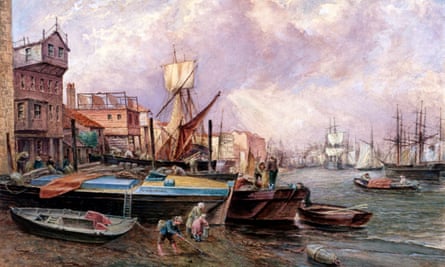
Earlier this week, Lara Maiklem climbed down to the foreshore of the River Thames at low tide to spend several hours gently scrabbling at its surface in pursuit of a 20-year obsession.
Known on social media as the London Mudlark and the author of three books on larking, Maiklem is at the forefront of a growing number of people spending their spare time combing through the mud of the capital’s river searching for historical artefacts.
Maiklem said: “I’ve spent the last 20 years trekking down to the muddy, cold, smelly foreshore. It’s obsessive, addictive, hypnotic. Once you start, it just draws you back.
“I go down there to get away from everything. And it’s a place you can time travel. You get this sense of the past that’s been locked away in the mud, sometimes for thousands of years.”

Maiklem started posting her finds on social media in 2012. Since then, enthusiasm for the pastime has become so great that the Port of London authority (PLA) has had to stop issuing licences for mudlarking. Between 2018 and 2022, demand for permits shot up from 200 a year to more than 5,000. The PLA was forced to act to “protect the integrity and archaeology of the foreshore”, it said.
This week, the Museum of London, which provides a home for significant finds on the Thames foreshore, announced a major exhibition, Secrets of the Thames: Mudlarking London’s Lost Treasures, opening next April.
Describing the tidal river as a “living time capsule”, the museum promised to tell the story of how generations of mudlarks have uncovered thousands of years of human history through finds ranging from clay pipes and false teeth to a Viking-era dagger and a medieval gold ring inscribed “For love I am given”.
Kate Sumnall, the exhibition’s curator, said: “We’re so familiar with the Thames just quietly flowing through the middle of the city. Many people don’t give it a second thought. It’s always been there, the city’s grown up around it, millions of people have lived alongside it. And bits and pieces of their lives have been dropped or thrown in, and have become preserved in the mud.”
Mudlarking on the Thames foreshore was first recorded about 200 years ago, but Sumnall said the practice was likely to predate the 19th century. “It tended to be people who lived in utter poverty that were scraping around, trying to find usable scraps that could be sold,” said Sumnall. Children were often sent to search for items to sell.

“In more recent years, it’s evolved into a practice where people get satisfaction from the search, the find, and then knowing that you’re the first person to touch something in potentially hundreds or even thousands of years.”
Mudlarking soared during the Covid pandemic, when organised and social activities were forbidden. But social media has also fuelled interest as posts about mudlarks’ discoveries have taken off.
Most finds are “everyday, ordinary things that people threw away or lost”, said Maiklem. “For me, that’s the beauty of it – these are ordinary people who have vanished from history but they might have left something.
“But also the river is such a beautiful place to go. In a frantic city it’s a place where you can sit and do nothing. You can look in it, and you can give it your problems, and it will take them away.”

Maiklem visits the foreshore once or twice a week. “I’ll spend five to six hours literally staring at mud. By the time I’m finished, I’m a much nicer person.”
Artefacts have been unearthed from prehistoric communities that camped, hunted and farmed along the river, the Romans who founded Londinium, and Vikings who travelled by water to expand their territory.
after newsletter promotion
Maiklem’s favourite discoveries are shoes. “They hold the essence of the individual, they’re so personal. When you pull a shoe out of the mud and you can see those little toe prints and the heel print of somebody who lived 500 years ago, it’s like reaching back through time. There’s something about shoes that send a shiver up my spine.”

Among items that will go on display at the Museum of London’s exhibition is a well-preserved knitted woollen cap that was trapped in the river mud about 500 years ago. “We’ve all had those moments where our hats have flown off in the wind, especially when you’re near water,” said Sumnall.
“We’ve also got an absolutely stunning, beautiful gold ring that comes from about 1450, and has a beautiful pink stone set into it. It’s really quite a modern design, being a solid band with an oval gemstone set within that solid band. If you saw it on a person today, it wouldn’t look out of place.
“It’s got some lettering around the outside, and the translation is, ‘For love, I am given’. So it was something given between lovers, perhaps at the point of engagement. And it is in as good a state now as it was when it was given.
“So what’s it doing in the river? Is it that it’s often cold by the river, and someone has pulled off a glove with the ring flying off as well? Or was it a lovers’ argument, the end of a relationship, the ring thrown in the water? Someone saying: ‘That’s it, I’m done’.”
The PLA said the Thames foreshore was London’s longest archaeological site, with finds dating back to 4500BC. Mudlarks, who until 2022 paid £106 for a three-year licence, are required to report all findings 300 years old or more to the Museum of London.
Of the 5,000 or so items reported to the museum each year, about 700 are recorded and a small number are taken into its collections.
 Print
Print


